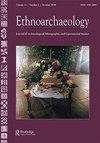五指粟栽培的民族考古与实验炭化研究[j]。在埃塞俄比亚西北部
IF 1.8
0 ARCHAEOLOGY
引用次数: 3
摘要
摘要在埃塞俄比亚西北部进行了一项关于dagusa (Amharic)种植的民族考古研究,dagusa (Amharic)在英语中通常被称为指粟(Eleusine coracana)。达古萨是东非和中非最重要的谷物和主食之一。实地研究考察了从土地整理到食品加工的作物加工活动。这项研究记录了传统的农业技术、土地种族、劳工组织、食物和与作物种植有关的仪式。通过炭化实验,研究了栽培和野生大沙品种在氧化和还原燃烧环境下的转化和保存情况。结果表明,在250°C ~ 350°C的温度范围内,种子颜色不同,存活率也不同。在这些较低的温度下,植物的所有组成部分都显示出更好的存活率。民族考古学和实验研究的结合表明,考古植物学家可以在哪里以及如何观察到粮食生产和加工小米的证据。本文章由计算机程序翻译,如有差异,请以英文原文为准。
Ethnoarchaeological and Experimental Charring Studies Related to the Cultivation of Finger Millet (Eleusine Coracana [L.] Gaertn.) in Northwestern Ethiopia
ABSTRACT An ethnoarchaeological study was conducted in northwestern Ethiopia on the cultivation of dagusa (Amharic), commonly known as finger millet (Eleusine coracana) in English. Dagusa is one of the most important cereals and staple foods in East and Central Africa. The field study examined crop-processing activities from land preparation to food processing. The study documented traditional agricultural techniques, land races, labor organization, foods, and rituals associated with cultivation of the crop. Experimental charring was conducted to examine the transformation and preservation of different varieties of dagusa including cultivated and wild progenitor varieties within both oxidized and reduced combustion environments. The results show that survivability varies by seed color at temperatures between 250°C and 350°C. All components of the plants show better rates of survivability at these lower temperatures. The combined ethnoarchaeological and experimental study suggest where and how archaeobotanists may observe evidence of food production and processing of finger millet.
求助全文
通过发布文献求助,成功后即可免费获取论文全文。
去求助
来源期刊

Ethnoarchaeology
ARCHAEOLOGY-
CiteScore
1.60
自引率
0.00%
发文量
10
期刊介绍:
Ethnoarchaeology, a cross-cultural peer-reviewed journal, focuses on the present position, impact of, and future prospects of ethnoarchaeological and experimental studies approaches to anthropological research. The primary goal of this journal is to provide practitioners with an intellectual platform to showcase and appraise current research and theoretical and methodological directions for the 21st century. Although there has been an exponential increase in ethnoarchaeological and experimental research in the past thirty years, there is little that unifies or defines our subdiscipline. Ethnoarchaeology addresses this need, exploring what distinguishes ethnoarchaeological and experimental approaches, what methods connect practitioners, and what unique suite of research attributes we contribute to the better understanding of the human condition. In addition to research articles, the journal publishes book and other media reviews, periodic theme issues, and position statements by noted scholars.
 求助内容:
求助内容: 应助结果提醒方式:
应助结果提醒方式:


